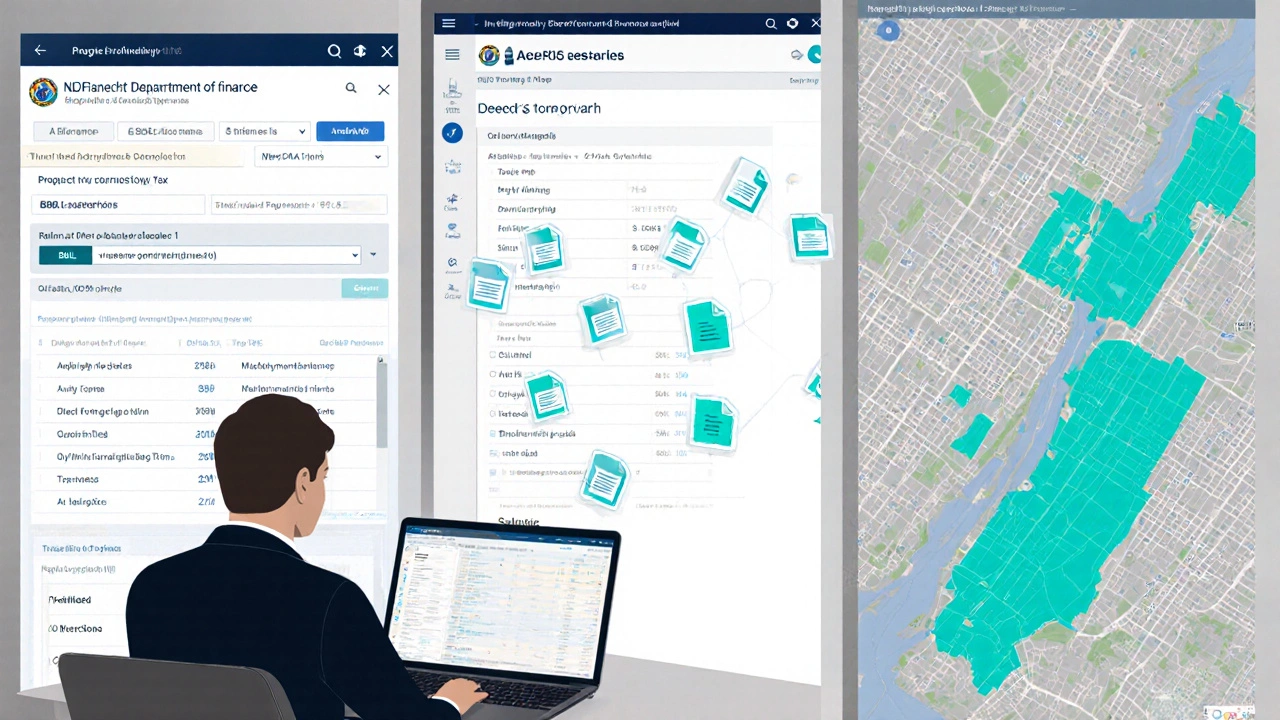NYC Building Ownership Lookup: Who Owns Every Property?

Oct, 20 2025
NYC BBL Format Converter and Owner Lookup Tool
Convert NYC BBL Format
BBL Information
BBL Format Variations
Owner Information
Enter an address or BBL to get building owner information from NYC property data sources
Pro Tip: This tool converts BBL formats and simulates owner lookup. For real owner information, use NYC Department of Finance or ACRIS directly.
Why NYC Building Ownership Matters
New York City’s skyline is a patchwork of family firms, REITs, foreign investors, and nonprofits. Knowing NYC building ownership helps investors spot trends, journalists expose hidden landlords, and tenants understand who controls their building. But the data lives in a maze of city agencies, each with its own portal and quirks.
NYC Department of Finance is the backbone of property ownership data. It collects annual property tax bills, maintains the Real Property Tax Service Center, and publishes ownership filings on its website. When you pull a record from the department, you’re seeing the official name of the owner as reported to the city for tax purposes.
Automated City Register (ACRIS) is the city’s digital filing cabinet for deeds, mortgages, and liens. Every time a property changes hands, a deed is recorded in ACRIS, making it the most reliable source for historic ownership chains.
Two other portals ship the same data in more user‑friendly formats: the NYC Open Data Portal, which hosts bulk CSV downloads of ownership information, and the PLUTO dataset, a geographic file that pairs parcels with zoning, land use, and owner names.
Understanding how these pieces fit together is the first job‑to‑be‑done for anyone asking, “Who owns what building in NYC?”
Key Data Sources Explained
Below is a quick rundown of the five most often‑used sources. Each offers a different angle on ownership, and together they give you a 360° view.
| Source | Primary Data | Update Frequency | Access Method | Best For |
|---|---|---|---|---|
| NYC Department of Finance - Real Property Tax Service Center | Current owner name, tax class, assessed value | Monthly | Web search by address or BBL | Quick owner lookup, tax history |
| ACRIS (Automated City Register) | Deeds, mortgages, liens, chain of title | Real‑time (as filings are entered) | Web interface + bulk XML/JSON feeds | Historical ownership chain, legal documents |
| NYC Open Data Portal - MapPLUTO | Parcel geometry, zoning, land use, owner name | Quarterly | CSV/GeoJSON download, API | Spatial analysis, bulk research |
| Property Tax Service Center - Pay NYC Taxes | Tax bills, payment history, exemptions | Monthly | Account‑based portal (requires registration) | Financial health of an owner |
| NYC GIS (Geographic Information System) | Layered maps, building footprints, owner parcels | Monthly | Interactive map, WMS/WFS services | Visualizing ownership across neighborhoods |
Step‑by‑Step: Finding the Owner of a Specific Building
- Gather the address and BBL. The Borough‑Block‑Lot (BBL) is the city’s unique identifier for every parcel. You can get it from any of the portals, but the quickest way is to type the address into the Department of Finance’s Property Tax Search and copy the BBL that appears.
- Search the Real Property Tax Service Center. Paste the BBL into the search box. The result page shows the current owner name, mailing address, and tax class. Note any “LLC” or “Trust” suffixes-these often hide the ultimate individual.
- Verify with ACRIS. Open the ACRIS Search and select “Document Type: Deed”. Input the BBL and set a date range covering the past five years. The latest deed will list the seller and buyer, giving you a legal confirmation of ownership.
- Cross‑check using PLUTO. Download the latest PLUTO CSV from the Open Data portal, filter by BBL, and review the “Owner Name” column. PLUTO also tells you the zoning and land‑use code-useful if you’re curious whether the building is mixed‑use, residential, or commercial.
- Inspect tax bills for red flags. If the owner appears as a shell LLC, pull the most recent tax bill from the Property Tax Service Center. Look for “Exemptions” (e.g., 421‑a) that might indicate a developer or a nonprofit.
- Map it with NYC GIS. Load the BBL into the GIS viewer to see surrounding parcels owned by the same entity. This visual step often reveals corporate portfolios that own multiple adjacent buildings.

Common Pitfalls and How to Avoid Them
- Out‑of‑date owners. The Department of Finance updates monthly, but ACRIS is real‑time. If a recent sale isn’t reflected in the tax search, it usually means the new owner hasn’t paid a tax bill yet.
- Shell companies. Many NYC owners hide behind LLCs or trusts. Use the New York State Department of State’s Corporation & Business Entity Search to look up the LLC name; you’ll often find the filing address, which can hint at the controlling party.
- Address variations. A single building can have multiple street names (e.g., “East 42nd St” vs. “E 42nd St”). Always cross‑verify using BBL, not just the street address.
- Data‑format mismatches. CSV files from the Open Data portal use “BBL” without hyphens, while the tax portal shows “B‑B‑L”. Convert consistently with Excel or a simple Python script.
Practical Uses of Ownership Data
Once you have a reliable owner name, a handful of real‑world actions become possible:
- Investor analysis. Compare the owner’s portfolio size, debt load (via recent mortgage recordings in ACRIS), and tax delinquency rate to gauge risk.
- Journalistic investigations. Trace patterns of foreign investment or gentrification by mapping all parcels owned by a single entity across boroughs.
- Tenant advocacy. Identify the landlord’s mailing address to file repair complaints or request a rent‑stabilization audit.
- Legal due diligence. Verify chain of title before purchasing a building; missing deed entries are red flags.
Third‑Party Tools That Simplify the Hunt
While the city’s portals are free, they can be cumbersome. Several commercial services layer the data and add search features:
- Zillow - Shows the “property tax” and “last sold” info, often pulling from ACRIS.
- StreetEasy - Highlights current listings and displays the “owner name” if the building is listed for sale.
- PropertyShark - Offers a paid “owner history” report that aggregates ACRIS, tax, and PLUTO data.
These tools are handy for quick checks, but always corroborate with the official city sources for legal certainty.

Quick Checklist for a Complete Ownership Profile
- Get the BBL from the address.
- Check the current owner on the Real Property Tax Service Center.
- Confirm the latest deed on ACRIS.
- Pull the PLUTO record for zoning and land‑use.
- Review the most recent tax bill for exemptions or delinquency.
- Map adjacent parcels on NYC GIS to spot portfolio patterns.
- Lookup LLC filing details on the NYS Department of State website.
Frequently Asked Questions
How can I find the BBL for a given address?
Enter the street address into the NYC Department of Finance’s Property Tax Search. The BBL appears at the top of the result page, formatted as Borough‑Block‑Lot (e.g., 1‑2345‑67).
Are ACRIS records public?
Yes. All deeds, mortgages, and liens filed with the city are accessible for free via the ACRIS web interface or bulk XML feeds. No login is required.
Why do some owners appear as LLCs?
LLCs provide liability protection and privacy. In NYC, many investors use LLCs to hold individual parcels, especially when the same entity owns dozens of buildings across boroughs.
Can I get historical ownership data for free?
Yes. By searching ACRIS for deeds dating back decades, you can reconstruct the chain of title without paying. Bulk downloads of historical PLUTO files are also available on the Open Data portal.
What’s the best way to spot foreign investors?
Look for owners with names that include “Ltd”, “LLC” in a foreign language, or addresses outside New York. Cross‑reference the entity on the NYS Department of State website; many foreign entities register a local agent in NY.
Next Steps for Different Users
If you’re an investor: Pull a full ACRIS title report, run a tax delinquency check, and map the owner’s other parcels on GIS before making an offer.
If you’re a journalist: Export a list of all LLC owners from PLUTO, then use the Department of State search to identify the individuals behind the shell companies.
If you’re a tenant: Find the landlord’s mailing address on the tax record, then contact them directly for repairs or use the NYC 311 portal if they’re unresponsive.
With the right combination of city data sources, you can answer the question “Who owns what building in NYC?” quickly, accurately, and with confidence.